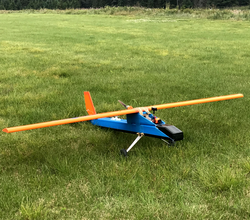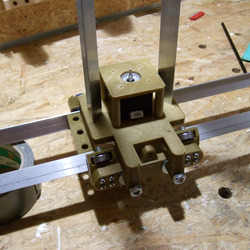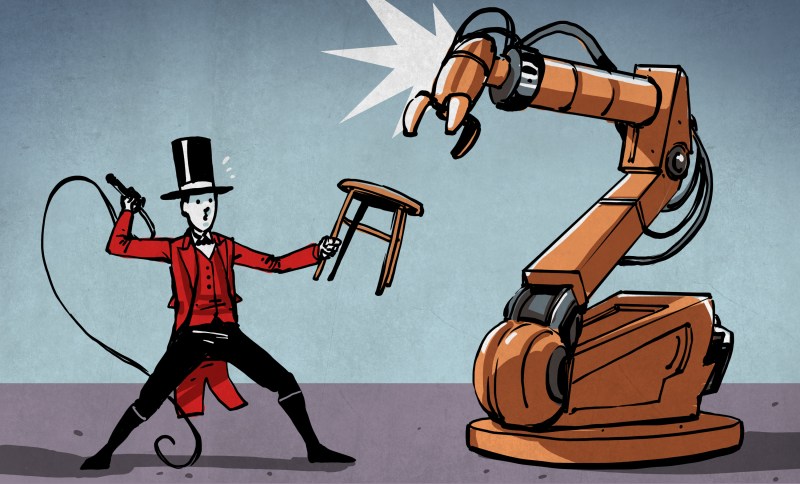“Keep it simple” sounds like such good advice, but what exactly is the “it”; what parts of a project should you try to keep simple? You can’t always make everything simple, can you? Are all kinds of “simplicity” equally valuable, or are there aspects of a design where simplicity has multiplier effects on the rest of the project?
I ran into two seemingly different, but surprisingly similar, design problems in the last couple weeks, and I realized that focusing on keeping one aspect of the project simple had a multiplier effect on the rest — simplifying the right part of the problem made everything drastically easier.

The first example was a scratch-built airplane design. I’d made a few planes over the summer, focusing on plans on the Interwebs that emphasize simplicity of the actual build. Consequently, the planes were a bit heavy, maybe not entirely aerodynamic, and probably underpowered. And this is because the effort you expend building the plane doesn’t fundamentally have anything to do with flight. Keeping the build simple doesn’t necessarily get you a good plane.
Weight, on the other hand, is central. Wings produce lift, whether measured in grams or ounces, and anything heavier just isn’t gonna fly. But reducing weight has a multiplier effect. Less weight means smaller and lighter motors and batteries. Structures don’t need to be as stiff if they’re not subject to heavier bending forces. And, important to the noob pilot, planes with less weight per wing area fly slower, giving me (ahem, the noob pilot) more reaction time when something goes sideways. Trying to simplify the design by trimming weight has knock-on effects all around.
My latest fully-DIY design threw out anything that brought weight along with it, including some parts I thought were necessary for stiffness or crash resistance. But with the significantly lowered weight, these problems evaporated without needing me to solve them — in a way, the complexity of design was creating the problems that the complexity of design was supposed to solve. Ditching it meant that I had a slow plane, with simple-to-build wings, that’s capable of carrying a lightweight FPV camera. Done and done! Simply.

At the same time, I’m building a four-axis CNC foam cutter. I’ve built many 3D printers, and played around with other folks’ DIY CNC machines, so I had a few design ideas in my head starting out. My first iteration of an XY axis for the machine runs on metal angle stock with a whopping eight skate bearings per axis. It’s strong and rigid, and clumsy and overkill, in a bad way for this machine.
3D printers want to move a relatively light tool head around a small volume, but relatively quickly. CNC mills need to be extremely rigid and shoulder heavy side loads, subject to some speed constraints. A foam cutter has none of these needs. The hot wire melts the foam by radiation, so there are no loads on the machine because it doesn’t even contact the workpiece. And because it cuts by melting, it has to go slow. These are the places in the design where simplification will bear the most fruit.
I write this in retrospect, or at least from the perspective of a second prototype. I wanted the first design to hold the cutting filament taut, hence the rigid frame. But separating the tension from the motion, by using a lightweight external bow to keep the filament tight, meant that the machine could be dead simple. I could use smaller plastic sliders instead of complex bearings, on thin rods instead of bulky rails. In a day after having this realization, I got twice as far as I had on the previous machine design in a week, and it takes up a lot less space in my basement.
So take your KISS to the next level. Brainstorm a while about the binding constraints on your design, and what relaxing any of them can do. Do any particular simplifications enable further simplifications? Those are the ones that you want to start with. Keep it simple, smartly. And because it’s not always easy to find these multiplier effects, tell your friends!
















Nice read
‘KISS’ is a corollary to Ocam’s Razer. But the acronym’s meaning is, originally, Keep It Simple, Stupid.
But there is the other principle of keeping it simple as possible, but not one bit simpler (Einstein).
And that, in a nutshell, is engineering.
[do I need any more idioms or metaphors here?]
Nope, it’s simplified just right.
Keep It Short and Sweet!
The real joy of this thinking is when you start cross-applying the principles.
My favorite is Ray Jardine, an aerospace engineer who loved to backpack, hiking the Pacific Crest Trail in 1987. When he looked at all the *crap* people (including himself) typically carried, he reasoned that it wasn’t much different from the classic Tsiolkovsky rocket equation. In simple terms “The heavier the stuff you bring, the more heavy stuff you need to bring it”. In the Rocket Equation the total weight of a rocket would be (very roughly) 90% propellant, 9% structure and ~1% payload (and yes, you can argue these numbers but it’s a rough example). These principles apply to a lot of other parts of engineering (and life), but rockets are among the most extreme, so saving an ounce of payload will save you 6.25 pounds of ancillary stuff.
As he pared pounds then ounces away from his pack, he went from needing heavy boots to light running shoes, heavy frame packs to much simpler and lighter systems and on it went. His mileage per day more than doubled and he wasn’t bringing a 60 lb pack and being miserable doing it.
Along the way he published his ideas in “Pacific Crest Trail Hiker’s Handbook: Innovative Techniques and Trail Tested Instruction for the Long Distance Hiker “, and it caught people’s imagination, That, in turn, spawned the (sometimes daffy) “ultralight backpacking” equipment industry that has provided lightweight and very durable equipment for a range of outdoor activities and has made getting out there a lot less of a misery than it used to be.
Also, guy with titanium tentpegs, kevlar/carbonfibre/goretex ‘shelter system’, vacuum packed freeze dried food, nanotech water filter, sports science enhanced footwear and clothing, etc etc to guy with modest camper “I don’t need all that modern technology to enjoy nature.”
Ultralight backpacking further lightens your load by removing the weight of excess money from your bank account.
Nice article! I liked that you came empirically to one of the inventive principles of TRIZ: Partial or excessive actions.
To raise the KISS to a even higher level don’t brainstorm! use TRIZ.
A friend (who has made a lot of money running a successful machine shop) would often say “Take care of the pennies and the dollars will take care of themselves.” It’s a similar concept: if you’re focused on minimizing the most important constraint, you won’t blow your money/mass/power budget in other ways.
Great article totally agree with the logic. Small fact check. “The hot wire melts the foam by radiation” Instead of “radiation”, think the word here is “conduction”
I think it’s radiation. Or are you suggesting conduction through the air? B/c it’s definitely non-contact, or can be.
When you’re foam-cutting by hand, you can feel the drag on the wire when you’re pulling too fast — that’s when you’re running the string into the foam. Otherwise, it just kinda cruises on through.
This probably only really matters when you’re going around tight corners, but what happens is that the center of the string lags if it’s contacting the foam, and any curves you have get funny. In my case, it messes up the leading edge of airfoils — they get cut funny in the middle of the wing.
You totally _can_ pull fast enough that you’re pulling the string into the foam, and that’s fine for straight lines. But the CNC isn’t gonna know.
That’s a super interesting way of looking at it. I still think a majority of the heat transfer is via conduction. The wire needs to physically touch the foam to cut. Fourier’s Law (Conduction) contributes a large amount heat when compared Stefan-Boltzmann Law (Radiation) for the same system.
I got pretty curious and found some random research paper doing thermal FEA on hotwire cutting on foam. Their thermal model only accounted for heat transfer via a conduction mode, and it seems that their experimental results lined up with the FEA model
https://pdfs.semanticscholar.org/1e80/0848a241431b3b42e72694e1fe19f91876d4.pdf
The force your feeling when you are going to fast, is trying to advance too fast before the foam has fully hits it’s melting point/ glass transition temperature (or whatever it’s called) Plastics are weird.
It’s Sunday and I’m feeling pretty lazy to dig deeper or do the hand calcs.
Anyways, I’m curious to hear your thoughts.
There is an additional lesson to be learned when looking at foam cutters. As they are so different from other CNC machines they allow using completely different and much simpler solutions.
A couple of years a go we build a foam cutter without any rails at all. We just had a bow that was suspended from strings. It is a similar concept as the Maslow CNC. But instead of 2 motors it was using 4 small steppers with fishing line directly wound on the shaft – two for each end of the wire. We mounted this underneath a table that would be put on another table of the same size. The lines were just redirected by eye hooks at the corners and then attached directly to the hot wire.
You could even run it in two configurations by having the bow along or across the table depending on which strings are hooked together.
So in the end most parts of a classical CNC machine basically disappeared.
Guess the lesson is: While well tested solutions may be a good starting point they may not be the best for your problem. Thinking outside the box may give you even simpler solutions that don’t apply in the common or general case.